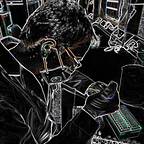Indian Rāgas 101: Bhairav
How can something be fresh, innocent, inspring, yet grave and sombre? Bhairav has always been a paradox to me. It sounds so scary at times, with its emphasis on komal re. Yet, it’s a morning raag. It’s the morning raag, supposed to be played in and around the time of sunrise.
The Bhairav thaat moves as follows
S r G M P d N S`
S` N d P M G, r P M G r, S
Note the prolonged stays in komal re and komal dha. Combined with the time it is supposed to be sung, Bhairav creates an ambience of introspection, bordering on fear. However, Indian raags simply refuse to be pigeonholed into a particular stereotype. If you are looking for positive vibes, sit with a Tanpura at daybreak, and follow the notes from the Master.
But here’s the thing: like all Indian raags, Bhairav has multiple personalities. It can inspire feelings of desperation and melancholy equally well. This song (‘Mohe bhool gaye saawariya’) by the legendary Lata Mangeshkar incites outright dread.
Bhairav is malleable, and can be put to great use by well endowed vocalists. This famous dance-floor scorcher by Sukhwinder Singh (‘Dard-e-disco’) never makes you, or lets you, think of morning (on the contrary, the song seems made for all-nighter parties).
Bhairav is subtly present in ‘Tanhayee’ by Sonu Nigam, where he squeezes out the pain in Bhairav (although, the komal ni is typical of Ahir Bhairav).
One variant of Bhairav , the Ahir Bhairav (the one with the komal ni and without the komal dha) is an insanely popular choice for composers. We’ll talk about it in the next tranche.
